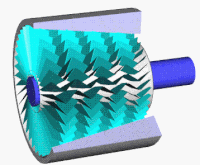
Photo from wikipedia
Abstract The interaction of secondary flows with the main passage flow in turbomachines results in entropy generation and in aerodynamic loss. This loss source is most relevant to low aspect… Click to show full abstract
Abstract The interaction of secondary flows with the main passage flow in turbomachines results in entropy generation and in aerodynamic loss. This loss source is most relevant to low aspect ratio blades. One approach for reducing this flow energy loss is by endwall contouring. However, limited work has been reported on using non-axisymmetric endwalls at the stator casing and on its interaction with the tip leakage flow. In this paper, a non-axisymmetric endwall design method for the stator casing is implemented through a novel surface definition, towards mitigating secondary flow losses. This design is tested on a three-dimensional axial turbine RANS model built in OpenFOAM 3.2 Extend, with k−ω SST turbulence closure. The flow analysis confirms the foundations of the new surface definition approach, which is implemented using Alstom Process and Optimization Workbench (APOW) software. Computer-based optimization of the surface topology is demonstrated towards automating the design process of axial turbines in an industrial design workflow. The design is optimized using the total pressure loss across the first stator and across the full stage, as the target function. Numerical predictions of the 1.5 stage axial turbine show the positive impact of the optimized casing design on the efficiency that increases by 0.69% against the benchmark axisymmetric stage from RWTH Aachen, which is validated against experiment. The new non-axisymmetric casing is also beneficial at off-design condition. The effective mitigation of the secondary flows is predicted to give a 0.73% efficiency gain off-design.
Journal Title: International Journal of Mechanical Sciences
Year Published: 2018
Link to full text (if available)
Share on Social Media: Sign Up to like & get
recommendations!